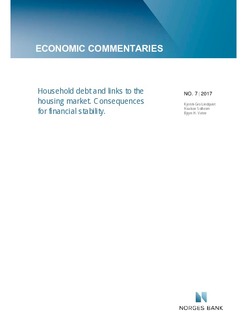| dc.contributor.author | Lindquist, Kjersti-Gro | |
| dc.contributor.author | Solheim, Haakon | |
| dc.contributor.author | Vatne, Bjørn Helge | |
| dc.date.accessioned | 2018-08-15T07:51:02Z | |
| dc.date.available | 2018-08-15T07:51:02Z | |
| dc.date.issued | 2017 | |
| dc.identifier.uri | http://hdl.handle.net/11250/2558006 | |
| dc.description.abstract | Household debt in Norway has risen faster than income for a long period. The debt level is high both historically and compared with other countries and is considered to be the most important source of vulnerability in the Norwegian financial system. High debt increases the probability that households will need to increase saving and tighten consumption in the event of a decline in house prices or a rise in interest rates. The risk of such a shift in consumption is assessed to be high. This risk is particularly high among households that have recently purchased a dwelling or have substantial exposure to the housing market. Residential mortgage credit risk - the risk of default and possible foreclosure with bank losses - is moderate overall. Higher consumer debt and increased investment in secondary homes may lead to higher credit risk exposure for banks. | nb_NO |
| dc.language.iso | eng | nb_NO |
| dc.publisher | Norges Bank | nb_NO |
| dc.relation.ispartofseries | Economic Commentaries;7/2017 | |
| dc.rights | Attribution-NonCommercial-NoDerivatives 4.0 Internasjonal | * |
| dc.rights.uri | http://creativecommons.org/licenses/by-nc-nd/4.0/deed.no | * |
| dc.title | Household Debt and Links to the Housing Market - Consequences for Financial Stability | nb_NO |
| dc.type | Others | nb_NO |
| dc.description.version | publishedVersion | nb_NO |
| dc.subject.nsi | VDP::Samfunnsvitenskap: 200::Økonomi: 210::Samfunnsøkonomi: 212 | nb_NO |
| dc.source.pagenumber | 22 | nb_NO |

